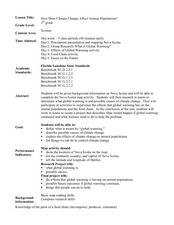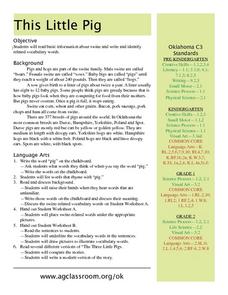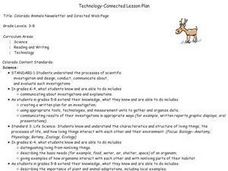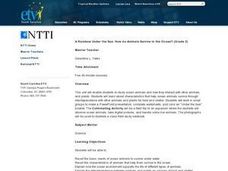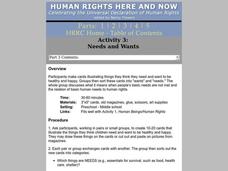Curated OER
How Does Climate Change Affect Animal Populations?
Young scholars investigate the effect of climate change on animal population in Nova Scotia. In this environmental science lesson, students complete a Nova Scotia map activity and research the causes of global warming in small groups....
Curated OER
Take an Ant to Lunch
Second graders construct a model of an ant, exemplifying that ants are insects. Students gather data create a pictograph chart to show ant food preferences. Also, 2nd graders access the Internet to explore ant eating habits.
Curated OER
Oh Deer! and English Learner Writing Extensions
Students follow deer through Yellowstone Park and record the number of deer from year to year. In this basic needs of deer lesson, students work in small groups and chart the number of deer each year and give explanations using as...
Curated OER
Don’t Cry Over Spoiled Milk!
Seventh graders explore how milk spoils over time. In this biology lesson, 7th graders discover how pH changes as microorganisms enter the food and multiply. They explain the benefits of pasteurization process.
Curated OER
This Little Pig
First graders study basic information about swine. They write and identify vocabulary words relating to the subject. They write a recipe for "Pigs in a Blanket," using canned crescent rolls and small sausages. They trade recipes and...
Curated OER
What's Wild
Third graders discover the differences between wild and domestic animals. In this animal lesson plan, 3rd graders chart the differences in the animals and look through magazines for pictures of wild and domestic animals to glue to a...
Curated OER
Colorado Animals Newsletter and Directed Web Page
Students select a Colorado animal, develop a Directed Web page, and research their animal. Each member of the group combine their research and develop a Newsletter.
Curated OER
The Spider Beside Her
Second graders are introduced to the characteristics of spiders. In groups, they compare and contrast spiders to different insects to discover spiders are not an insect at all. In groups, they create a model of a spider and discuss its...
Curated OER
The Ancient Mediterranean: Trade, Contact, and Cultural Diffusion
Ninth graders begin the lesson by being introduced to the basic terms of economics. In groups, they discover how they are affected by trade because of the clothes they wear and foods they eat. Using primary sources, they examine the...
Curated OER
Starvation in the Ghettos
Learners consider the lack of nutrition experienced in Holocaust ghettos. In this Holocaust lesson, students investigate the Nazi policy of starving people out of the ghettos through their food rationing program. Learners compare Nazi...
Curated OER
How Can We Keep Our Forests Intact and Have Our Chocolate Too?
Fourth graders explore various methods of growing and harvesting rainforest foods in order to sustain its biodiversity. They discuss the various uses for trees from several viewpoints. Students research chocolate demand and land use...
Arizona-Sonora Desert Museum
Desert People and the Saguaro
The saguaro is the focus of an examination of the importance of this stately cactus to the indigenous people in the Sonoran Desert.
Curated OER
Obesity, Eating Habits and Weight Loss
Students conduct Internet research, view film and participate in class discussion to identify the problem and causes of obesity in America. They evaluate the food pyramid and break down the nutritional components of fast food and frozen...
Curated OER
A Balanced Diet
High schoolers determine which healthy foods comprise a well balanced meal. Using a checklist, students classify foods as healthy or unhealthy. This lesson is intended for high schoolers acquiring English.
Curated OER
Starvation in the Ghettos
Students investigate how human beings survive under camp and ghetto life's extreme condition while understanding the USRDA requirements. They recognize the suffering and loss of life due to the lack of adequate nutrition.
Curated OER
Protein Puzzles
Students examine the concept of protein structure. They read an article, construct a three-dimensional model of an insulin protein, take a quiz, conduct Internet research, and answer discussion questions.
Curated OER
The Brown Rice Bonus
Students investigate how brown rice can be incorporated into a daily healthy diet. They practice preparing and storing the rice in the most beneficial ways. Also goals are set to increase the consumption of it in the dose of twice a week.
Curated OER
Farming in a Fishbowl: How Ethnic Groups in
Seventh graders research Chinese agricultural needs and practices. They conduct an experiment with aquaculture and germinated rice as they take measurements and apply the scientific method.
Curated OER
Outdoor Survival
Students are introduced to basic outdoor survival concepts. They identify the seven basic needs for survival. Students describe the symptoms and treatment for frostbite and hypothermia. They compare and contrast the value of different...
Curated OER
Hunters/Gatherers
Students discuss the ways in which an environment is used to provide the basic necessities of life. In groups, they compare and contrast how different hunter and gatherer groups have used the environment to their advantage. They place...
Curated OER
Caribbean Culture Day
Students are introduced to about Caribbean culture through the preparation and sampling of Caribbean food, as well as become familiar with Caribbean folk songs and poetry. They also experience blindness in order to form a deeper...
Curated OER
Make Waves
Sixth graders discover, through exploration, the basic characteristics of waves. After a lecture/demo, 6th graders work in groups and participate in a series of labs where they investigate waves. Each group presents its findings to the...
Curated OER
A Rainbow Under the Sea: How do Animals Survive in the Ocean?
Second graders read books, watch videos, complete worksheets and participate in class discussions about ocean animals. They, in groups, design PowerPoint presentations on selected marine animals.
Curated OER
Needs And Wants
Learners make cards illustrating things they think they need and want to be healthy and happy. Groups then sort these cards into "wants" and "needs." The whole class discusses what it means when people's basic needs are not met and the...
